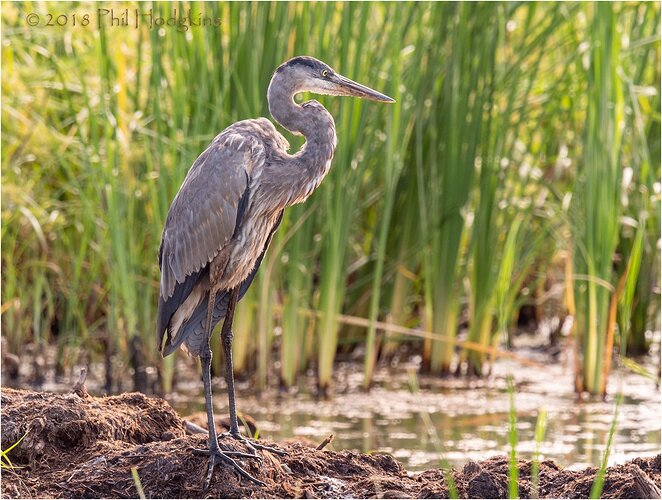Camera Info: Nikon D500, HH, braced in SUV window
Lens: VR 300mm f/4E + 1.4x TC
Focal Length: 420mm
Focus Mode: AF-C
AF-Area Mode: Dynamic, 25 points
VR: ON
Aperture: f/7.1
Shutter Speed: 1/250s
Exposure Mode: Aperture Priority
Exposure Comp.: 0EV
Metering: Spot
ISO Sensitivity: ISO 400
66% of full frame
PP in LR/PS CC 2018, Topaz Studio, Camera Raw filter, TK sharpen for web @ 35%
What technical feedback would you like if any?
Is the DOF adequate, or should it be more blurred? Should it be darker?
What artistic feedback would you like if any?
Do I need more room for the feet? I would have to make it as that is the bottom of the frame.
Nice pose and I like the lighting, Phil. I think the feet are fine. With those long legs, you don’t need much room at the bottom. It’s a close call, but if this were mine, I’d probably blur the reeds just a bit and perhaps darken the the veriest trifle to help contrast with the heron. You didn’t ask, but I’d probably remove the out of focus foreground reeds as well.
1 Like
Phil, you’ve got a nice close frame of this juvenile. To me the DOF looks pretty good. You’re almost wide open with that glass combination. I think you needed just a little DOF to get the whole bird in focus at that range. As for the BG it’s sufficiantly defocused which to me looks natural, and the color of the GBH allows it to stand out. I don’t see any real need for more room at the bottom, as the bank is not attractive. But I do agree that the cleaned up FG grasses helps, particularly those taller ones on the right.
I’m just curious, are your subjects always on one side of the car, or do you have to move back and forth?
I like the changes, Phil. It was a nice shot to begin with, but the second one is even better.
Dennis, I learned something on this from your comment. I didn’t realize that long legs made a difference in their feet being allowed a little closer to the bottom of the frame. It does seem to make sense tho, as with that tall of a subject, making more room for his feet will cause the photographer to center the bird more from the top to bottom. I sure am learning a lot on NPN!
Bill, for the most part on the driver’s side of the car, although it pays occasionally to check the passenger side, as one of the main canals is on that side. Since the loop road through the wildlife refuge is one way, it works that way. Plus the damage sustained from Hurricane Irma last year has changed the water pattern such that the right side of the road has grown up to be an impenetrable thicket of weeds. The damage is a busted dike on the main canal, such that the USFWS has only limited control of water flow. To date, there have not been funds allocated for the repair or for previously planned vegetation control. The COE is in charge of the repair. Funds generally have gone lacking for good management. Sad!
The repost is definitely an improvement.I too don’t think you need more room in the bottom. The background in the original was a little odd - it was neither in nor out of focus, so blurring it made a big difference. The foreground grasses did not bother me, but taking them out helped.
Phil, around here on the MS coast I don’t have the luxury of shooting from the car. Lake Martin, which is a good distance for me near Lafayette, used to be good several years ago, but the last ten years the rookery is populated much farther from the road. so birds are just not that close by. I have a bean bag but never bring it. Mia McPherson suggested using a pool noodle, like oversized foam pipe insulation. Ronnie Gaubert, who used to post on NPN before he died, had great success from his truck at Lake Martin. I’m convinced that shooting from the car is the least disruptive method of bird and wildlife photography, and thereby the most productive.
Bayou Sauvage, the largest US wildlife refuge within city limits, used to be wonderful for bird photography, and I would go over there at least twice a month. But it is nothing like it used to be, and I think that funding is a major factor, coupled with a lack of food because the sloughs and ponds are choked with overgrowth. If there’s no open water, the wading birds will go elsewhere to survive. Sad indeed.
Bill, you have hit on the real problems with the refuge system—the ones I know around here suffer from under-funding in both maintenance and management. A good example is the local Savannah NWR. Irma last year blew out a major dike which has yet to be fixed, a year later. This has limited the water management, encouraged the invasion of aggressive plant systems and moved the bird population around considerably. The migratory population has dropped dramatically, and the predators that follow it (hawks, eagles, etc) are seldom seen. This administration seems to place little value on the refuge system. I don’t particularly hold this against the local managers; they do the best they can with what they are allotted.

